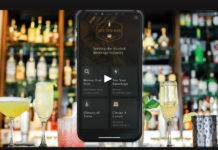
According to Wired.com, Marcos Lutyens, a multimedia artist interested in the neurological condition of synesthesia, has invented a device that aims to broaden minds after just one sip of a cocktail, as the experience of taste is translated into individual artworks through the brain. Lutyens is working alongside Absolut Vodka to bring cocktail drinkers a visual representation of how their brains are enjoying their drinks with the FlavourCollider, at next month’s FutureEverything festival in Manchester, England.
There is a lot of mathematical theory and science that goes into the installation of the FlavourCollider. Roy Williams’ Xmorphia, a mathematical system that generates forms that mimic the building blocks of life, forms the basis for the algorithm that translates the drinkers’ brainwaves into art.
“I’m more like a kind of orchestra conductor,” said Lutyens, explaining his role in the work. “It’s very multidisciplinary, as we’re mixing brain waves with taste with visuals, and bringing them together is where my work sits. What I do like about the visuals is that they emerge mostly out of these algorithms, these equations which allow signals from our brain to create self-generative art.”
The images produced were created by Lutyen’s research and the efforts of the “Xname” coding team led by Claude Heiland-Allen. Lutyens studied people’s reactions to cocktails created by Absolut supertaster Bex Almqvist. Participants were asked to discern the shape, texture, form, movement, and color through their taste buds.
The creation of the visual programming was also informed by the Bouba/Kiki effect, discovered by German psychologist Wolfgang Kohler. The effect demonstrated the brain’s association between words and shapes. “On that basis, we associated a sharp taste, like chili, with more angular shapes than a smooth taste.”
Color has remained one confusing factor in the visualization of taste. Lutyens said “It’s a difficult one because although the cocktail comes with a color, that isn’t necessarily the color of the taste it may have. Red, for example, is often associated with strawberry but also with chili. Color becomes less important to decipher a flavor than form, and the density of patterns and speed of movement when it came to writing the code.”








